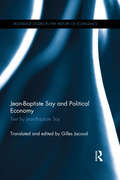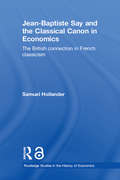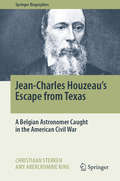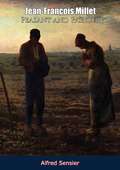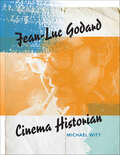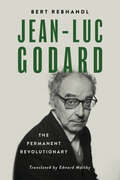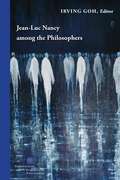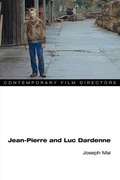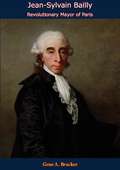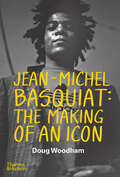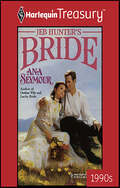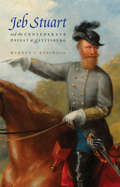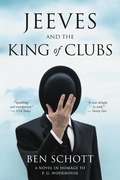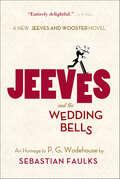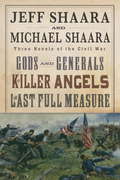- Table View
- List View
Jean-Baptiste Say and Political Economy: Or The Production, Distribution, And Consumption Of Wealth. By Jean Baptiste Say. Tr. From The 4th Ed. Of The French (Routledge Studies in the History of Economics)
by Jean-Baptiste SayJean-Baptiste Say (1767–1832) was one of the first great economists to have laid down the foundations of economic science. Author of the famous Treatise on Political Economy in 1803, which was revised and re-edited on several occasions, he published numerous other works including a voluminous Complete Course in Practical Political Economy in 1828–9. He also taught political economy successively from 1815 until his death in three Parisian establishments: the Athénée, the Conservatory of Arts and Trades, and the Collège de France. <P><P> The texts in which Say exposes his approach to political economy have not been available in the English language until now except for the fourth edition of the ‘Preliminary Discourse’ which serves as an introduction to the Treatise. This book presents a translation which renders his works accessible to the English speaking world. For the first time, English readers will be able to become directly immersed in Say’s principal texts, where he develops his conception of political economy. Jean-Baptiste Say and Political Economy proposes a translation of a selection of eleven of Say’s texts. The first three are versions of the ‘Preliminary Discourse’ from the Treatise’s editions of 1803, 1814 and 1826 with the variations of the editions of 1817, 1819 and 1841. The following four texts are the opening discourses pronounced at the Conservatory in 1820 and 1828 and the Collège de France in 1831 and 1832. The eighth text is the ‘General Considerations’ which open the Complete Course in Practical Political Economy of 1828, with the variations of the 1840 re-edition. The final three texts are those Say devotes to ‘the progress of political economy’ in what is akin to a history of economic thought. <P><P> This volume is of great importance to economic historians and people studying Jean-Baptiste Say, as well as those who are interested in economic theory and philosophy and political economy.
Jean-Baptiste Say and the Classical Canon in Economics: The British Connection in French Classicism (Routledge Studies in the History of Economics #Vol. 72)
by Samuel HollanderThis book explores the perceived paradigmatic conflict within British classical economics between the so called 'Ricardo School' and the contemporary French Economics of Jean-Baptiste Say. Samuel Hollander provides the reader with extensive evidence, utilizing all editions of Say's main texts and his lesser-known writings in order to demonstrate his adherence to much of Ricardian theory. This intriguing book focuses on selected doctorinal issues and surrounding debates, and will interest all serious historians of economic thought, finding a place on the bookshelves of many economists across the world.
Jean-Baptiste Say: Revolutionary, Entrepreneur, Economist (Routledge Studies in the History of Economics)
by Evert SchoorlThis volume is the first full-length biography of Jean-Baptiste Say (1767-1832), the most famous French classical economist. During his lifetime Say actively took part in three revolutions: the French Revolution, the Industrial Revolution and the establishment of economics as an academic discipline. He struggled with Bonaparte, was the owner of a cotton spinning mill, and published his famous Treatise of political economy and many other economic writings.
Jean-Charles Houzeau's Escape from Texas: A Belgian Astronomer Caught in the American Civil War (Springer Biographies)
by Christiaan Sterken Amy Abercrombie KingTranslated from the original French and annotated with figures, historical maps and commentary from the translators, this work is Jean-Charles Houzeau's account of his escape from Texas during the American Civil War. Houzeau was a Belgian astronomer who worked a couple of years as assistant astronomer at the Brussels Observatory, but eventually moved to the United States. He was living as a frontierman in Texas when the Civil War broke out, and because he took an abolitionist stance and helped slaves escape, he was forced to flee to Mexico, from where he sailed to New Orleans on board of a US military vessel. Originally titled La terreur blanche au Texas et mon 'evasion, Houzeau captured the details of his escape in 1862.The editors, an astronomer and a French language teacher, have added supplementary material to give the readers more depth and historical context to the story.
Jean-François Millet Peasant and Painter
by Alfred SensierThe story of the life and work of French painter Jean-François Millet (1814-1875), written by his friend, confidante and correspondent Alfred Sensier.“For more than thirty years we lived Millet’s life, receiving his confidences and complaints, and knowing his innermost thoughts. We loved him; he knew our affection for him, and withheld no confidences from us.Millet had a suffering and melancholy nature, but he was first of all a man of strong convictions. Faithful and proud in his religion and his art, to these he sacrificed pleasure, repose, and even his life, which was shortened by his struggles.We therefore publish a life of Millet from his own words and testimony. There is nothing to hide. Everything is healthy, pure, and instructive.”
Jean-Luc Godard, Cinema Historian
by Michael WittOriginally released as a videographic experiment in film history, Jean-Luc Godard's Histoire(s) du cinéma has pioneered how we think about and narrate cinema history, and in how history is taught through cinema. In this stunningly illustrated volume, Michael Witt explores Godard's landmark work as both a specimen of an artist's vision and a philosophical statement on the history of film. Witt contextualizes Godard's theories and approaches to historiography and provides a guide to the wide-ranging cinematic, aesthetic, and cultural forces that shaped Godard's groundbreaking ideas on the history of cinema.
Jean-Luc Godard: The Permanent Revolutionary (Wisconsin Film Studies)
by Bert RebhandlIn this biography, now translated into English for the first time, Bert Rebhandl provides a balanced evaluation of the work of one of the most original and influential film directors of all time: Jean-Luc Godard (1930–2022). In this sympathetic yet critical overview, he argues that Godard's work captured the revolutionary spirit of Paris in the late 1960s as no other filmmaker has dared, and in fact reinvented the medium. Rebhandl skillfully weaves together biographical details; information about the cultural, intellectual, and cinematic milieu over the decades; and descriptions of Godard’s most significant films to support his assertion that the director was a permanent revolutionary—always seeking new ways to create, understand, and comment on film within a larger context. He views Godard as an artist consistently true to himself while never ceasing to change and evolve, often in unexpected, radical, and controversial ways. Rebhandl is known as a journalist with deep insights and lucid prose. Despite the wealth of material to analyze, he neither gets lost in the details nor offers a superficial gloss, even while directly tackling such topics as the long-standing charges of antisemitism against Godard and his oeuvre. This volume will be welcome to both casual fans and dedicated devotees.
Jean-Luc Nancy among the Philosophers (Perspectives in Continental Philosophy)
by Irving GohThis volume focuses on the relational aspect of Jean-Luc Nancy’s thinking. As Nancy himself showed, thinking might be a solitary activity but it is never singular in its dimension. Building on or breaking away from other thoughts, especially those by thinkers who had come before, thinking is always plural, relational. This “singular plural” dimension of thought in Nancy’s philosophical writings demands explication.In this book, some of today’s leading scholars in the theoretical humanities shed light on how Nancy’s thought both shares with and departs from Descartes, Hegel, Marx, Heidegger, Weil, Lacan, Merleau-Ponty, and Lyotard, elucidating “the sharing of voices,” in Nancy’s phrase, between Nancy and these thinkers.Contributors: Georges Van Den Abbeele, Emily Apter, Rodolphe Gasché, Werner Hamacher, Eleanor Kaufman, Marie-Eve Morin, Timothy Murray, Jean-Luc Nancy, and John H. Smith
Jean-Pierre Jeunet (Contemporary Film Directors)
by Elizabeth EzraThis is the first book on Jean-Pierre Jeunet, the popular and critically acclaimed director of films such as Amélie, Delicatessen, A Very Long Engagement, Alien Resurrection, and City of Lost Children. Jeunet's work exemplifies Europe's engagement with Hollywood, while at the same time making him a figurehead of the critically overlooked, specifically French tradition of the cinema of the fantastic. Having garnered both commercial success and critical esteem in genres such as science fiction, fantasy, romantic comedy, and the war epic, Jeunet's work nevertheless engages with key aspects of French history and contemporary French culture. This study analyzes the director's major films, including those he made with Marc Caro, and his early short works. Elizabeth Ezra brings a new perspective to the study of Jeunet's work, uncovering instances of repressed historical trauma involving France's role in Algeria and the Second World War. The book includes a commentary by Jeunet himself on his career and corpus of films.
Jean-Pierre and Luc Dardenne (Contemporary Film Directors)
by Joseph MaiFor well over a decade, Jean-Pierre and Luc Dardenne have produced highly original and ethically charged films that immerse their audiences in an intense and embodied viewing experience. Their work has consistently attracted international recognition, including the rare feat of two Palmes d'Or at Cannes. In this first book-length study of the Belgian brothers, Joseph Mai delivers sophisticated close analyses of their directorial style and explores the many philosophical issues dealt with in their films (especially the ethics of Emmanuel Levinas). Mai discusses the Dardennes' varied and searching career from its inception in the late 1970s, starting with the working-class political consciousness and lost utopias of their documentary period; passing through their transition toward fictional narrative, experimental techniques, and familial themes; and finishing with a series of in-depth and philosophically informed interpretations of the brothers' more recent work. In such highly influential films such as La promesse, Rosetta, The Son, and The Child, the brothers have recast filmmaking through what Mai calls a "sensuous realism"--realism capable of touching the audience with the most compelling problems and moral dilemmas of contemporary society. This volume also features an interview in which the Dardennes discuss their approach to film production and the direction of actors.
Jean-Sylvain Bailly: Revolutionary Mayor of Paris
by Gene A. BruckerA study of Jean Sylvain Bailly (1736-1793), the French astronomer, mathematician, freemason, and political leader of the early part of the French Revolution.“IT IS CHARACTERISTIC of great revolutions that they are initiated by moderate men, who desire only limited reforms and who are most reluctant to resort to violence to obtain their ends. So began the French Revolution, and such a moderate was Jean-Sylvain Bailly, who, as mayor of Paris during the years 1789-91, struggled to maintain a balance between the two extremes of radicalism and reaction. He failed and paid for his failure on the guillotine. A study of his mayoral regime throws interesting light on these moderates in the early days of the Revolution, their character and aims, the problems which faced them and their attempts to solve them, the manner in which they strived to keep themselves in power, and how they failed.”
Jean-Michel Basquiat: The Making of an Icon
by Doug WoodhamThe first biography in more than a quarter century—based on more than 100 interviews—adds significant new information to the story both of Jean-Michel Basquiat's life and to the extraordinary journey of his art. In a resurrection few could have predicted, Jean-Michel Basquiat joined Picasso, Modigliani, and Munch when one of his paintings sold for more than $100 million. Nearly four decades after his untimely death at 27 years of age, Basquiat is one of the most recognizable artists in the world, his work not just headlining major museum and private collections but his image on T-shirts, sneakers, tattoos, and accessories from Rio to Singapore. Drawing on more than 100 interviews—including family members, friends, lovers, gallery owners, collectors, musicians, academics, and artists—art-world insider Doug Woodham offers a revealing account of Basquiat's life, work, and enduring legacy. He delves into Basquiat’s rich and complex family background, his overlapping identities, and the dramatic arc of his posthumous fall and rise—an ascent that has reshaped the art-world itself. This behind-the-scenes narrative pulls back the curtain on how the art world selects its icons and cements their place in history. The first substantive biography in more than a quarter century, Jean-Michel Basquiat: The Making of an Icon examines key aspects of the artist's life—his childhood trauma, sexuality, cultural identities, and struggles with addiction—topics long downplayed in the museum and art world due to pressure from his estate. Woodham also uncovers the previously untold story of how a few against-the-grain speculators and gallerists—plus his uniquely skilled father—all contributed to bringing what Basquiat accomplished back to the center of the conversation nearly a decade after his death, and in the process helped to birth a new era in contemporary art.
Jeannette
by John Howard Terry PerichJeannette, the Glass City, was named in honor of H. Sellers McKee's wife and was the first large manufacturing town within Westmoreland County. On May 20, 1889, the first glass was blown, and Jeannette began sending its glass products all over the world. There were seven great glass factories located in the area, as well as the largest pressed-glass factory in America and the largest window glass plant in the world. Two of the largest factories in the world were the McKee Brothers' Works and the Chambers-McKee Glass Company. Jeannette produced more glass in various forms than any other place in the United States. Jeannette was also home to Oakford Park, a trolley park, for the relaxation of its citizens and those in the surrounding areas. The great Oakford Park flood, which took place on July 5, 1903, was the most devastating event in western Pennsylvania since the Johnstown flood of 1889. Oakford Park was rebuilt, and Jeannette recovered and continued producing glass.
Jeannette (Postcard History Series)
by Terry Perich Kathleen PerichJeannette, the Glass City, was the first industrial city in Westmoreland County. From Jeannette's founding in 1888 by Pittsburgh industrialist H. Sellers McKee, the city was destined for fame. Jeannette produced more glass in various forms than any other city in the world. At one time there were seven great glass factories in Jeannette, all producing glass that was shipped worldwide. Jeannette was a beautiful planned Victorian town, and the residents were proud of their city. A new form of correspondence became popular: the penny postcard. Jeannette features postcards showing the area's Victorian mansions, workers' row houses, factories, schools, churches, businesses, streets, and government buildings.
Jeannie’s Demise: Abortion on Trial in Victorian Toronto
by Ian RadforthAugust 1, 1875, Toronto: The naked body of a young woman is discovered in a pine box, half-buried in a ditch along Bloor Street. So begins Jeannie’s Demise, a real-life Victorian melodrama that played out in the bustling streets and courtrooms of “Toronto the Good,” cast with all the lurid stock characters of the genre. Historian Ian Radforth brings to life an era in which abortion was illegal, criminal proceedings were a spectator sport, and coded advertisements for back-alley procedures ran in the margins of newspapers. At the centre of the story is the elusive and doomed Jeannie Gilmour, a minister’s daughter whose independent spirit can only be glimpsed through secondhand accounts and courtroom reports. As rumours swirl about her final weeks and her abortionists stand trial for their lives, a riveted public grapples with questions of guilt and justice, innocence and intent. Radforth’s intensive research grounds the tragedy of Jeannie’s demise in sharp historical analysis, presenting over a dozen case studies of similar trials in Victorian-era Canada. Part gripping procedural, part meticulous autopsy, Jeannie’s Demise opens a rare window into the hidden history of a woman’s right to choose.
Jeb Hunter's Bride
by Ana SeymourA WOMAN ALONE,yet determined to fulfill her dying father's golden dream, Kerry Gallivan heeded the siren call of pioneering and set out on "the sea of grass." But how was she to know that while she sailed her prairie schooner, Jeb Hunter would become captain of her fate?A MAN APARTWagon master for a Conestoga caravan west, Jeb Hunter held the lives of his people in his hands...and a guilty secret in his soul. Haunted by the past, he had no future-until Kerry Gallivan schemed her way onto his train, and into his heart!
Jeb Stuart and the Confederate Defeat at Gettysburg
by Warren C. Robinson&“The Army was much embarrassed by the absence of the cavalry,&” Robert E. Lee wrote of the Gettysburg campaign, stirring a controversy that continues even today. Lee&’s statement was an indirect indictment of Gen. James Ewell Brown (&“Jeb&”) Stuart, who was the cavalry. This book reexamines the questions that have shadowed the legendary Confederate hero and offers a fresh, informed interpretation of his role at Gettysburg.Avoiding the partisan pros and cons characterizing previous accounts, Warren C. Robinson reassesses the historical record to come to a clearer view of Stuart&’s orders for the crucial battle (as well as what was expected of him), of his actual performance, and of the impact his late arrival had on the outcome of the campaign. Though Stuart may not have disobeyed Lee&’s orders, Robinson argues, he did abuse the general&’s discretion by raiding Washington rather than scouting for the army at Gettysburg—a move that profoundly affected Confederate fortunes and perhaps the war itself.
Jedburgh Operations: Support To The French Resistance In Eastern Brittany From June-September 1944
by Major Ralph D. NicholsSpecially trained teams, known as Jedburghs, were inserted into France in conjunction with Operation "Overlord," to help liberate it from German occupation. The Jedburghs were three-man allied teams, comprised of two commissioned officers, (at least one French) and a non-commissioned officer in charge of the radio (wireless telegraphy). All Jedburghs were volunteers. They received highly specialized training in guerrilla warfare. Jedburghs served in harm's way, deep behind enemy lines. They were subordinate to the Supreme Headquarters Allied Expeditionary Force (SHAEF), and its commander, General Dwight D. Eisenhower. Their covert mission in Operation "Overlord" helped pave the way for the liberation of France, and ultimately resulted in a campaign to free Europe from Nazi rule.This study explores the origins, purpose, training and missions of the Jedburghs. I will examine the actual operations of seven Jedburgh teams in Eastern Brittany. Their actions and effectiveness will be compared with operations of other Jedburgh teams.
Jeeps 1941-45
by Hugh Johnson Steven ZalogaThe jeep was the most famous military vehicle of World War II, and its name has become synonymous with a whole class of military and civilian all-terrain vehicles. The jeep originated in a prewar US Army requirement for a simple, inexpensive, and robust vehicle for basic utility chores. Its simple design proved to be adaptable to a host of military tasks including use as a scout vehicle, battlefield ambulance, communications vehicle, and staff car. This book, covering "the savior of World War II", focuses on the design and development of this versatile vehicle used on nearly every front of World War II. From the Trade Paperback edition.
Jeeves and the King of Clubs: A Novel in Homage to P.G. Wodehouse
by Ben SchottWhat ho! A new Jeeves and Wooster novel, penned in homage to P.G. Wodehouse by bestselling author Ben Schott--in which literature's favorite gentleman and his gentleman's personal gentleman become spies in service to the Crown.The misadventures of P.G. Wodehouse's Bertie Wooster and his incomparable valet, Jeeves, have delighted audiences for nearly a century. Now, bestselling author Ben Schott brings this odd couple back to life in a madcap new adventure that is full of the hijinks, entanglements, imbroglios, and Wodehousian wordplay that readers love. And, by Jove, there's a hook!In this escapade, the Junior Ganymede Club (Jeeves's association of butlers and valets) is revealed to be an arm of the British intelligence service. Jeeves must ferret out a Fascist spy, and only his hapless employer can help. Unfolding in the background are school-chum capers, affairs of the heart, drawing-room escapades, antics with aunts, and sartorial set-tos. Energized by Schott's effervescent prose, Jeeves and the King of Clubs delights longtime fans and introduces a new audience to the comic joys of these beloved characters.
Jeeves and the Leap of Faith: A Novel in Homage to P. G. Wodehouse
by Ben SchottJeeves and Wooster return in a new espionage caper full of japes, high jinks, and jiggery-pokery in a series that is &“impossible to read without grinning idiotically&” (Evening Standard). The Drones club&’s in peril. Gussie&’s in love. Spode&’s on the war path. Oh, and His Majesty&’s Government needs a favor . . . I say! It&’s a good thing Bertie&’s back, what? In his eagerly anticipated sequel to Jeeves and the King of Clubs, Ben Schott leads Jeeves and Wooster on another elegantly uproarious escapade. From the mean streets of Mayfair to the scheming spires of Cambridge, we encounter a joyous cast of characters: chiseling painters and criminal bookies, eccentric philosophers and dodgy clairvoyants, appalling poets and pocket dictators, vexatious aunts and their vicious hounds. But that&’s not all: Who is ICEBERG, and why is he covered in chalk? Why is Jeeves reading Winnie-the-Pooh? What is seven across and eighty-five down? How do you play Russian Roulette at The Savoy? These questions, and more, are answered in Jeeves and the Leap of Faith — an homage to P.G. Wodehouse, authorized by his estate, and essential reading for fans of The Master. Tinkety-tonk!
Jeeves and the Wedding Bells, an Homage to P.G. Wodehouse
by Sebastian FaulksBertie Wooster (a young man about town) and his butler Jeeves (the very model of the modern manservant)--return in their first new novel in nearly forty years: Jeeves and the Wedding Bells by Sebastian Faulks. P.G. Wodehouse documented the lives of the inimitable Jeeves and Wooster for nearly sixty years, from their first appearance in 1915 ("Extricating Young Gussie") to his final completed novel (Aunts Aren't Gentlemen) in 1974. These two were the finest creations of a novelist widely proclaimed to be the finest comic English writer by critics and fans alike. Now, forty years later, Bertie and Jeeves return in a hilarious affair of mix-ups and mishaps. With the approval of the Wodehouse estate, acclaimed novelist Sebastian Faulks brings these two back to life for their legion of fans. Bertie, nursing a bit of heartbreak over the recent engagement of one Georgina Meadowes to someone not named Wooster, agrees to "help" his old friend Peregrine "Woody" Beeching, whose own romance is foundering. That this means an outing to Dorset, away from an impending visit from Aunt Agatha, is merely an extra benefit. Almost immediately, things go awry and the simple plan quickly becomes complicated. Jeeves ends up impersonating one Lord Etringham, while Bertie pretends to be Jeeves' manservant "Wilberforce,"--and this all happens under the same roof as the now affianced Ms. Meadowes. From there the plot becomes even more hilarious and convoluted, in a brilliantly conceived, seamlessly written comic work worthy of the master himself. A Kirkus Reviews Best Fiction Book of 2013
Jeeves and the Wedding Bells: An Homage To P. G. Wodehouse (Jeeves and Wooster)
by Sebastian FaulksBertie Wooster (a young man about town) and his butler Jeeves (the very model of the modern manservant)—return in their first new novel in nearly forty years: Jeeves and the Wedding Bells by Sebastian Faulks. P.G. Wodehouse documented the lives of the inimitable Jeeves and Wooster for nearly sixty years, from their first appearance in 1915 ("Extricating Young Gussie") to his final completed novel (Aunts Aren't Gentlemen) in 1974. These two were the finest creations of a novelist widely proclaimed to be the finest comic English writer by critics and fans alike. Now, forty years later, Bertie and Jeeves return in a hilarious affair of mix-ups and mishaps. With the approval of the Wodehouse estate, acclaimed novelist Sebastian Faulks brings these two back to life for their legion of fans. Bertie, nursing a bit of heartbreak over the recent engagement of one Georgina Meadowes to someone not named Wooster, agrees to "help" his old friend Peregrine "Woody" Beeching, whose own romance is foundering. That this means an outing to Dorset, away from an impending visit from Aunt Agatha, is merely an extra benefit. Almost immediately, things go awry and the simple plan quickly becomes complicated. Jeeves ends up impersonating one Lord Etringham, while Bertie pretends to be Jeeves' manservant "Wilberforce,"—and this all happens under the same roof as the now affianced Ms. Meadowes. From there the plot becomes even more hilarious and convoluted, in a brilliantly conceived, seamlessly written comic work worthy of the master himself.A Kirkus Reviews Best Fiction Book of 2013
Jeff Shaara and Michael Shaara: Three Novels of the Civil War
by Jeff Shaara Michael ShaaraMichael Shaara reinvented the war novel with his Pulitzer Prize-winning masterpiece of Gettysburg, The Killer Angels. Jeff Shaara propelled his father's legacy to new heights with a series of centuries-spanning New York Times bestsellers. Together at last in eBook form, this volume assembles three Civil War novels from America's first family of military fiction: Gods and Generals, The Killer Angels, and The Last Full Measure. Gods and Generals traces the lives, passions, and careers of the great military leaders--Thomas "Stonewall" Jackson, Winfield Scott Hancock, Joshua Chamberlain--from the gathering clouds of war. The Killer Angels re-creates the fight for America's destiny in the Battle of Gettysburg, the four most bloody and courageous days of our nation's history. And The Last Full Measure brings to life the final two years of the Civil War, chasing the escalating conflict between Robert E. Lee and Ulysses S. Grant--complicated, heroic, and deeply troubled men--through to its riveting conclusion at Appomattox. Contains a preview Jeff Shaara's highly anticipated new novel of the Civil War, A Blaze of Glory.
